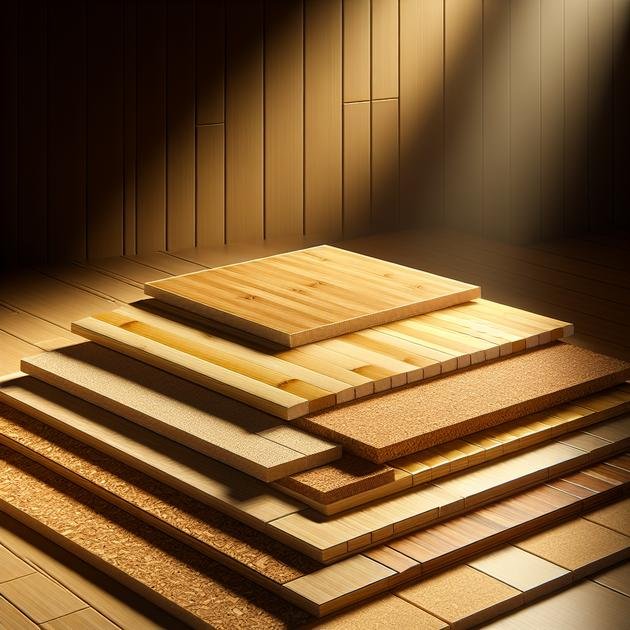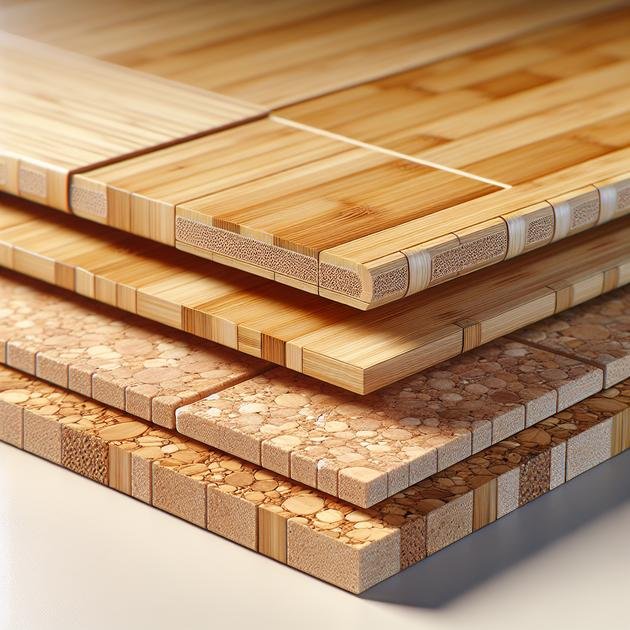Eco friendly flooring uses sustainable, renewable materials like bamboo, cork, and reclaimed wood that reduce environmental impact, improve indoor air quality, and offer durable, stylish options for natural homes.
Exploring eco friendly flooring opens a path to making your home greener without sacrificing style. Ever wondered which options truly balance nature and comfort? Let’s dive into choices that can transform your space and mindset.
what makes flooring eco friendly
Eco friendly flooring refers to flooring materials and practices that minimize environmental impact throughout their lifecycle, from production to disposal. These floors use renewable, recyclable, or sustainably sourced materials that reduce harm to the planet. Key factors include low emissions of volatile organic compounds (VOCs), ensuring better indoor air quality, and using non-toxic adhesives or finishes.
Another important aspect is the durability and lifespan of the flooring. Floors that last longer reduce the need for replacement, thus saving resources and energy. Sustainable harvesting methods, such as FSC-certified wood, guarantee that forests are responsibly managed. Finally, the ability to recycle or repurpose flooring materials at the end of their life ensures a circular economy, minimizing landfill waste.
Material considerations
Common eco-friendly flooring materials include bamboo, cork, reclaimed wood, and natural linoleum—all known for being renewable and biodegradable. These options avoid synthetic chemicals and plastics that contribute to pollution. Additionally, production processes that use renewable energy sources reduce carbon footprint significantly.
When selecting eco-friendly flooring, look for certifications like GreenGuard, FSC, or FloorScore that verify environmental and health standards. Choosing flooring with transparent labeling helps make responsible decisions easier for homeowners committed to sustainability.
benefits of using eco friendly flooring in homes
Eco friendly flooring brings multiple benefits to homes beyond just being better for the environment. One of the main advantages is improved indoor air quality. Many eco-friendly options release fewer volatile organic compounds (VOCs), chemicals that can harm health and cause allergies or respiratory issues.
Using sustainable materials like bamboo or cork also means your home supports responsible resource management. These materials grow quickly and can be harvested with minimal impact, unlike traditional hardwoods that may involve deforestation.
Durability and comfort
Eco flooring often offers great durability, resisting wear and tear to last longer. This reduces the need for frequent replacements, saving money and lowering waste. Many natural materials also provide a comfortable and warm feel underfoot, enhancing living spaces.
Another key benefit is aesthetic versatility. Eco-friendly floors come in a variety of colors and textures that suit rustic, modern, or classic home designs. Choosing these floors shows a commitment to sustainability without compromising style.
Finally, many products are biodegradable or recyclable, reducing landfill impact when it’s time for a change. Homeowners who prioritize eco flooring contribute to a healthier planet while enjoying a safe, attractive, and comfortable home environment.
types of materials used for eco friendly flooring
Eco friendly flooring comes from a variety of materials that each offer unique benefits for sustainability and home comfort. Bamboo flooring is popular due to its rapid regrowth and strength, making it a renewable and durable option. It has a modern look while being environmentally responsible.
Cork flooring is harvested from the bark of cork oak trees without harming them. This makes cork a sustainable choice that also provides natural insulation and a soft, comfortable feel underfoot.
Other popular eco materials
Reclaimed wood flooring uses salvaged wood from old buildings or furniture, reducing waste and preserving resources. It adds a unique character and history to any space. Natural linoleum is made from renewable materials like linseed oil and wood flour, offering biodegradability and resistance to fire and allergens.
Additional options include walnut, teak, and other sustainably harvested hardwoods certified by organizations like FSC. Wool carpets and reclaimed rubber tiles further expand the eco-friendly palette, providing alternatives to synthetic flooring.
When choosing materials, consider sourcing transparency and certifications that guarantee environmentally responsible production. This helps ensure your flooring choice supports eco-friendly living from origin to installation.
bamboo flooring and its sustainability

Bamboo flooring is one of the most sustainable flooring options available today. Bamboo is a fast-growing grass that can reach maturity in just 3 to 5 years, compared to traditional hardwood trees which can take decades. This rapid growth means it can be harvested frequently without causing deforestation or long-term environmental damage.
Another key factor in bamboo’s sustainability is that its harvesting process does not require replanting because new shoots grow naturally from the root system. This helps maintain soil stability and reduces erosion risks. Additionally, bamboo requires less water and pesticides than many hardwood trees, making its cultivation more eco-friendly.
Environmental benefits
Bamboo flooring also provides excellent carbon sequestration. During its growth, bamboo absorbs significant amounts of carbon dioxide, helping to reduce greenhouse gases. When used as flooring, it locks that carbon within the material for years to come.
Many bamboo flooring products are manufactured with low-VOC finishes and adhesives, contributing to healthier indoor air quality. Choosing bamboo flooring certified by reputable organizations ensures that sustainable harvesting and manufacturing practices are followed.
In summary, bamboo flooring combines durability, beauty, and a smaller ecological footprint, making it a top choice for homeowners focused on sustainable living.
cork flooring advantages and care tips
Cork flooring offers several advantages that make it a popular eco-friendly choice. It is harvested from the bark of the cork oak tree without damaging the tree, allowing the bark to regenerate naturally. This sustainable harvesting process can be repeated every 9 to 12 years, making cork a renewable resource.
Cork is naturally resistant to moisture, mold, and mildew, which helps improve indoor air quality. It also provides excellent sound insulation and feels soft and warm underfoot, increasing comfort in living spaces.
Durability and maintenance
Cork floors are durable and can withstand daily wear if properly cared for. However, they can be prone to dents and scratches from heavy furniture or sharp objects. Using furniture pads and avoiding high heels can help protect the surface.
To maintain cork flooring, clean regularly with a vacuum or dry mop to remove dirt and grit. Avoid excessive water when mopping; instead, use a damp mop with a mild, pH-neutral cleaner. Applying a sealant every few years will help preserve the floor’s finish and protect it from stains and moisture.
Overall, cork flooring combines environmental responsibility with practical benefits, making it a smart choice for eco-conscious homeowners.
reclaimed wood as a flooring choice
Reclaimed wood flooring is an eco-friendly option that involves repurposing wood from old buildings, barns, or furniture. This practice reduces the demand for newly harvested timber, helping to preserve forests and lower environmental impact.
Using reclaimed wood adds character and history to a home, as the wood often features unique textures, colors, and grain patterns unavailable in new materials. Each plank can tell a story, creating a warm and inviting atmosphere.
Durability and sustainability
Reclaimed wood is usually very durable since it comes from mature trees that grew slowly and developed tight grain structures. Properly treated and installed reclaimed wood floors can last for decades. Choosing finishes and adhesives with low VOCs enhances indoor air quality.
One key benefit of reclaimed wood is its contribution to a circular economy by extending the life of materials and reducing waste in landfills. It’s important to source reclaimed wood from reputable suppliers who ensure the wood is free of contaminants like lead paint or nails.
natural linoleum and its eco credentials
Natural linoleum is an eco-friendly flooring material made from renewable resources such as linseed oil, wood flour, cork dust, and natural pigments. It offers a sustainable alternative to vinyl flooring, which is made from non-renewable petroleum-based products.
One of the key eco credentials of natural linoleum is its biodegradability. Unlike synthetic flooring, natural linoleum breaks down naturally at the end of its life cycle, reducing landfill waste. It also has a low environmental footprint during production, as many of its components are sourced from sustainably managed farms.
Health and durability benefits
Natural linoleum contains no harmful chemicals or volatile organic compounds (VOCs), making it a safe choice for indoor air quality. It also boasts strong durability and resistance to wear, making it suitable for both residential and commercial spaces.
Maintenance of natural linoleum is straightforward, requiring regular sweeping and occasional damp mopping with mild cleaners. Its natural antibacterial properties contribute to a healthier home environment.
Choosing natural linoleum supports sustainable living by combining renewability, durability, and health benefits in one flooring solution.
how to choose flooring based on environmental impact

Choosing flooring based on environmental impact involves evaluating materials on several key factors that affect the planet. Start by considering the source of the material: sustainably harvested or rapidly renewable options like bamboo or cork are preferable over those contributing to deforestation.
Life cycle assessment is important. It measures the energy and resources used from production to disposal. Materials with lower energy consumption and minimal chemical usage produce less pollution and carbon emissions.
Certifications and transparency
Look for flooring products certified by trusted organizations such as FSC (Forest Stewardship Council), GreenGuard, or FloorScore. These labels guarantee responsible sourcing, low emissions, and safe indoor air quality.
Also, consider the durability and lifespan of the flooring. Long-lasting materials reduce the need for replacements and waste generation. Recyclability and end-of-life disposal impact the overall footprint as well. Avoid floors with harmful adhesives or finishes that emit volatile organic compounds (VOCs).
By assessing these factors and prioritizing renewable resources, low emissions, and recyclability, you can select flooring that supports a healthier home and a more sustainable planet.
installation tips for eco friendly flooring
Installing eco friendly flooring requires careful planning to ensure both durability and environmental benefits. Start by preparing the subfloor properly—clean, level, and dry surfaces help prevent issues like warping or unevenness after installation.
Choosing the right adhesives and materials
Use low-VOC or non-toxic adhesives and finishes to maintain good indoor air quality. Many eco flooring products offer click-lock or glue-free installation systems which reduce the need for chemical adhesives altogether.
When possible, reuse or recycle existing flooring materials during the installation process to minimize waste. If old flooring must be removed, consider donating or repurposing it rather than sending it to a landfill.
Ensure accurate measurements to reduce excess material waste. Ordering slightly more than needed helps account for cutting errors but avoid overordering which leads to disposal problems.
Professional vs. DIY installation
While some eco-friendly flooring types like bamboo or cork can be installed by experienced DIYers, professional installation often ensures longer-lasting results. Certified installers are familiar with best practices to preserve the flooring’s eco benefits and maintain warranties.
Lastly, follow the manufacturer’s guidelines for acclimation time. Allowing the flooring to adjust to the room’s humidity and temperature before installation helps prevent expansion or contraction issues later.
cost considerations for eco friendly flooring
When considering eco friendly flooring, cost is an important factor but should be weighed alongside long-term value and environmental benefits. Prices vary widely depending on the material, quality, and installation complexity.
Bamboo and cork tend to be mid-range options, offering a good balance between affordability and sustainability. They grow quickly, which helps keep costs down while supporting eco-friendly sourcing.
Higher-end choices
Reclaimed wood or sustainably harvested hardwoods may come at a premium due to the labor-intensive sourcing and unique character they offer. However, they provide durability and often increase home resale value, making them worthwhile investments.
Natural linoleum can vary, with costs influenced by manufacturing methods and regional availability. It often competes with synthetic vinyl flooring in price but holds an ecological advantage.
Installation costs should also be factored in—some eco flooring options are easier to install yourself, while others require professional help. Using low-VOC adhesives or specialized finishes may add to expenses but benefit indoor air quality and longevity.
Consider lifecycle costs too: durable, eco-friendly floors reduce replacement needs and waste. Balancing upfront investment with sustainability goals helps ensure you get the best value for your money and the planet.
maintaining and cleaning eco flooring responsibly
Maintaining and cleaning eco flooring responsibly ensures its beauty and longevity while protecting the environment. Start with regular cleaning using a soft broom or vacuum to remove dust and debris, which prevents scratches.
Cleaning methods
Use a damp mop with water and a mild, biodegradable cleaner specifically designed for natural or eco-friendly floors. Avoid harsh chemicals or abrasive cleaners, as they can damage the flooring and release harmful substances.
For spills, clean them up immediately to prevent stains or moisture damage, especially on materials like cork or wood. Use cloths or mops that are gentle and absorbent.
Protecting the floor
Place felt pads under furniture legs to prevent dents and scratches. Limit exposure to direct sunlight to avoid fading by using curtains or blinds.
Schedule periodic deep cleaning or refinishing with eco-friendly products as recommended by the flooring manufacturer. This maintains the floor’s protective layer without harming indoor air quality.
Proper maintenance extends the life of your eco flooring, reduces the need for replacement, and supports a healthier home environment.
impact of flooring on indoor air quality

The type of flooring you choose can significantly affect indoor air quality. Many traditional flooring options release volatile organic compounds (VOCs), which are harmful chemicals that evaporate into the air and can cause respiratory issues and allergies.
Eco friendly flooring materials like bamboo, cork, and natural linoleum typically emit far fewer VOCs, contributing to a healthier indoor environment. These floors often use low-emission adhesives and finishes that reduce the presence of harmful pollutants.
The role of flooring in air quality
Additionally, some materials like cork have natural antimicrobial properties that help reduce dust mites and mold, common triggers of asthma and allergies. Choosing flooring that does not trap dust and is easy to clean also supports better air quality.
Regular maintenance and cleaning using non-toxic products are essential to prevent buildup of allergens and maintain a fresh indoor atmosphere. Proper ventilation further enhances the benefits of eco flooring on air quality.
Overall, selecting low-emission, sustainable flooring options plays a key role in creating a safe, comfortable home with cleaner air.
common myths about eco friendly flooring
Many misconceptions surround eco friendly flooring, which can confuse homeowners considering sustainable options. One common myth is that eco-friendly floors are always expensive. While some materials carry a higher initial cost, options like bamboo and cork often fit within average budgets and save money over time due to durability.
Another myth is that sustainable flooring lacks variety or style. In reality, eco-friendly options come in diverse colors, textures, and finishes to suit any decor, from rustic to modern.
Performance and maintenance myths
Some believe eco flooring is less durable or harder to maintain. On the contrary, many eco materials like reclaimed wood or linoleum are highly durable when properly cared for and often require less harsh cleaning products.
There is also the misconception that eco flooring has a negative environmental impact due to production processes. Reputable manufacturers follow strict sustainability standards and certifications to minimize emissions and resource use.
Understanding these myths helps homeowners make informed decisions and appreciate the true benefits of choosing environmentally responsible flooring.
how eco flooring supports sustainable living
Eco flooring plays a crucial role in supporting sustainable living by reducing environmental impact throughout its life cycle. Using materials like bamboo, cork, and reclaimed wood helps preserve natural resources and limits deforestation.
These floors often require less energy and water during production compared to traditional flooring options. Their longevity means fewer replacements, which reduces waste and conserves materials.
Health and ecological benefits
Many eco-friendly floors emit low or no volatile organic compounds (VOCs), promoting healthier indoor air quality. Sustainable flooring choices also encourage circular economies by using recycled or renewable resources and promoting recycling at the end of their lifespan.
Choosing eco flooring encourages mindful consumption and supports industries committed to environmental protection. It aligns home design with broader goals of minimizing carbon footprints and conserving ecosystems.
By selecting sustainable flooring, homeowners contribute positively to the planet while enjoying durable, attractive, and safe living spaces.
future trends in sustainable flooring
Future trends in sustainable flooring focus on innovation, improved materials, and greater environmental responsibility. Advances in technology are leading to flooring options made from recycled plastics, agricultural waste, and even bio-based composites that reduce reliance on traditional resources.
Smart flooring systems integrated with sensors are emerging, allowing homeowners to monitor indoor air quality, temperature, and wear, which extends floor lifespan and promotes healthy living spaces.
Design and materials innovation
There is a growing demand for customizable eco-friendly floors with diverse colors and textures that do not sacrifice sustainability. Manufacturers are exploring natural dyes and zero-waste production processes to minimize environmental impact.
Recycling and upcycling will play a larger role, with modular flooring systems designed for easy replacement and reuse. This circular approach helps reduce landfill waste and conserve resources.
Biodegradable and carbon-negative flooring materials are being researched, aiming to create products that actively reverse environmental damage. Consumer awareness and stricter regulations are expected to drive widespread adoption of greener flooring choices in the coming years.
Making the switch to eco friendly flooring
Choosing eco friendly flooring is a smart way to create a beautiful home while protecting the planet. With so many sustainable options available, you can find floors that fit your style, budget, and values.
By focusing on materials that are renewable, low in harmful emissions, and durable, you help improve indoor air quality and reduce waste. Small changes in flooring can make a big difference for your health and the environment.
As technology and awareness grow, sustainable flooring will become even more accessible and innovative. Taking thoughtful steps today means supporting a cleaner, greener home for years to come.





